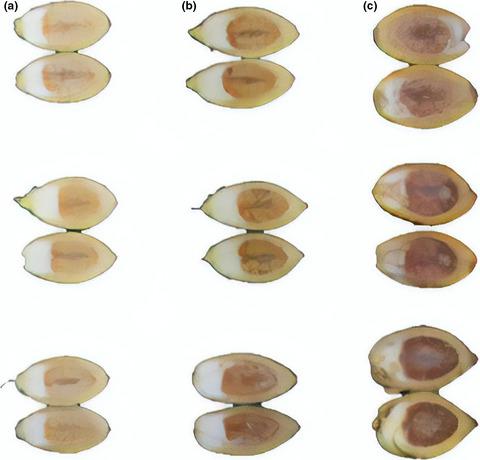当前位置:
X-MOL 学术
›
Food Sci. Nutr.
›
论文详情
Our official English website, www.x-mol.net, welcomes your
feedback! (Note: you will need to create a separate account there.)
Study on the browning mechanism of betel nut (Betel catechu L.) kernel.
Food Science & Nutrition ( IF 3.5 ) Pub Date : 2020-03-10 , DOI: 10.1002/fsn3.1456 Yuting Guo 1 , Yonggui Pan 1 , Zhengke Zhang 1 , Weimin Zhang 1
Food Science & Nutrition ( IF 3.5 ) Pub Date : 2020-03-10 , DOI: 10.1002/fsn3.1456 Yuting Guo 1 , Yonggui Pan 1 , Zhengke Zhang 1 , Weimin Zhang 1
Affiliation

|
Taking betel nut (Betel catechu L.) kernel as raw materials, to analyze the browning mechanism of betel nut kernel. First, we extract and separate the phenolic substances and polyphenol oxidase (PPO) from the betel nut kernel and then find out how O2 penetrates into the kernel, study the above 3 key factors of enzymatic browning so as to prove the possibility of enzymatic browning, and further study the browning products to clarify the mechanism of browning of betel nut kernel during storage process. The results showed that 11 kinds of phenolic compounds were isolated and identified from the betel nut kernel by liquid chromatography–mass spectrometry, among which chlorogenic acid was the highest, followed by dopamine and L‐epicatechin, and other contents were relatively low. Meanwhile, PPO was also separated from the betel nut kernel by DEAE–Sepharose Fast Flow and Phenyl–Sepharose 6 Fast Flow column chromatography. On this basis, scanning electron microscopy showed that the damage of the betel nut tissue was aggravated with the prolonged storage time, the wax was gradually decomposed, and the stratum corneum of the peel is destroyed in a honeycomb‐shaped; the lignification of the flesh was aggravated, and the interstitial space was increased; and the crack of the kernel membrane was also enlarged. These changes of structure contribute to increase gas exchange within and outside the organization, including the entry of O2. Finally, the oxidation products generated from simulated reaction of chlorogenic acid, dopamine, and epicatechin with purified PPO under aerobic conditions in vitro were compared with the products extracted from naturally brown betel nut, and the same absorption spectra were found. Therefore, it indicates that the browning of betel nut kernel is an enzymatic browning caused by the reaction of phenolic substrates were oxidized by PPO.
中文翻译:

槟榔(Betel catechu L.)仁褐变机理研究.
以槟榔( Betel catechu L.)仁为原料,分析槟榔仁的褐变机理。首先,我们从槟榔仁中提取分离出酚类物质和多酚氧化酶(PPO),然后找出O 2是如何渗透到仁中的,研究上述3个酶促褐变的关键因素,从而证明酶促褐变的可能性。 ,进一步研究褐变产物,阐明槟榔仁在贮藏过程中褐变的机理。结果表明,通过液相色谱-质谱法从槟榔仁中分离鉴定出11种酚类化合物,其中绿原酸含量最高,其次是多巴胺和L-表儿茶素,其他含量较低。同时,通过 DEAE–Sepharose Fast Flow 和 Phenyl–Sepharose 6 Fast Flow 柱层析也从槟榔仁中分离出 PPO。在此基础上,扫描电镜显示,随着存放时间的延长,槟榔组织损伤加剧,蜡质逐渐分解,果皮角质层被破坏成蜂窝状;果肉木质化加剧,间隙增大;仁膜裂纹也扩大。这些结构的变化有助于增加组织内外的气体交换,包括O 2的进入。最后,将绿原酸、多巴胺、表儿茶素与纯化的PPO在体外有氧条件下模拟反应生成的氧化产物与天然棕槟榔提取的产物进行比较,发现相同的吸收光谱。 由此可见,槟榔仁的褐变是酚类底物被PPO氧化反应引起的酶促褐变。
更新日期:2020-03-10
中文翻译:

槟榔(Betel catechu L.)仁褐变机理研究.
以槟榔( Betel catechu L.)仁为原料,分析槟榔仁的褐变机理。首先,我们从槟榔仁中提取分离出酚类物质和多酚氧化酶(PPO),然后找出O 2是如何渗透到仁中的,研究上述3个酶促褐变的关键因素,从而证明酶促褐变的可能性。 ,进一步研究褐变产物,阐明槟榔仁在贮藏过程中褐变的机理。结果表明,通过液相色谱-质谱法从槟榔仁中分离鉴定出11种酚类化合物,其中绿原酸含量最高,其次是多巴胺和L-表儿茶素,其他含量较低。同时,通过 DEAE–Sepharose Fast Flow 和 Phenyl–Sepharose 6 Fast Flow 柱层析也从槟榔仁中分离出 PPO。在此基础上,扫描电镜显示,随着存放时间的延长,槟榔组织损伤加剧,蜡质逐渐分解,果皮角质层被破坏成蜂窝状;果肉木质化加剧,间隙增大;仁膜裂纹也扩大。这些结构的变化有助于增加组织内外的气体交换,包括O 2的进入。最后,将绿原酸、多巴胺、表儿茶素与纯化的PPO在体外有氧条件下模拟反应生成的氧化产物与天然棕槟榔提取的产物进行比较,发现相同的吸收光谱。 由此可见,槟榔仁的褐变是酚类底物被PPO氧化反应引起的酶促褐变。











































 京公网安备 11010802027423号
京公网安备 11010802027423号